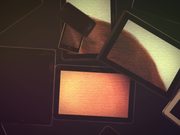Noise Machine no.1 - no.26. 2014
Noise Machine no.1 - no.26.
Media installation at TRUNK GALLERY. seoul. korea. 2014
Consciousness and Noise: Telenoiatic Utopia
/ A Note on Suk, Sung-Suk’s Work
Yoo won Joon [Art Critic]
Scene #1 Paranoiac Meditation on TechnologyA sort of paranoia?
Suk, Sung-Suk’s work stems from a persistent and obstinate doubt. Being unnecessary, doubt is a fundamental actuator that grounds his works. From the past, the Suk has continued multi-media experimental works that has formed from the materiality of media itself to the conscious level it symbolizes. His works were still far from digital transition, but closer to a ‘low-tech’ than a high-technology. It comes out of his intentional choice because he did not think that his meditation on technology was enough to pace up with such a transition and unfold. Also, to weigh up today’s technology from the past one and to imagine future’s technology, is an invariant way of measurement method as our technology’s history testifies. Therefore, the substantial question on the facing changes currently presented with digital should precede it. Analogue, the constituent world which has constituted us, was simultaneously a technological system and a biorhythmically phenomenon reflecting our lives. At the moment when the primordial unit comprising materials is converted into numbers, however, the signal was remediated, and our consciousness, that was once constituent, became segmented. A paranoiac meditation on technology derives from there. When the digital segmentation of constituent notions of analogue exists, what kind of changes would the segmented continuity accompany it? What would we lose in the crack of segments? Is something what comes about out of a crack-gap information or noise?
Scene #2 Consciousness. Continuation and Suspension
This is the point where the artist intervenes: the very point of a crack-gap between analogue and digital, old and new, and where mediation and remediation cut through and appropriate. And the artist names a series of information bundles that rise here as “noise.” The noise generated in the gap of suspension. It is not important in which system of value we may apprehend it; what is really important is the fact that noise already comes about, and we experience new aesthetics through it. Suk, Sung-Suk, once in the past, proposed the new era’s portrait which was composed with distorted electronic pictures on his Electronic Portrait. It was, after all, our own figure segmented as well as the image of our time, exposing the transfer out of canvases toward media. It is an interesting part here that the segment images on this work are so constituent and intentional ones, collected consciously from analogue images although they look like digital particles. It can be said that the artist proposes discontinuous elements of analogue medium as a series of noise by expanding and reproducing them. It is a troublesome question, however, to reconsider whether we should see them as a noise. What we should rather pay our attention here is that the collected noise derives from the artist’s intention. He generates noise on purpose, particularly in very media-like ways. An intentional noise derails its own category. On a conceptual point, this noise is not occurred unintentionally-purposelessly-randomly in the end, thus estranged from its intrinsic nature. On another perspective to consider the definition of noise as what is determined by the presence confirmation of the intentions about information/contents, the noise generated by the artist reverts paradoxically to a sort of information image or message that cannot be called as a noise. Let’s turn back to the questions previously suggested, then. Why does the artist intervene such an in-between gap? Which contents would the message, a series of the message generated by the intervention of itself, contain?
Scene #3 Disconnection of Analogue Signal
The artist shows a series of analogue TV receivers in this exhibition. They are the mechanical devices that have been disposed due to their abolition of use since the close of analogue broadcast. The TV monitors as the equipment to receive electronic signals acquire aesthetic values (as mechanical installation objects) from their external factors, meaning external appearances. Moreover, because TV has been recognized as a symbolic technological medium since Nam June Paik’s time (symbolizing a high-tech then, but low-tech now), a property is granted to TV that it can no longer be comprehended as a mere mechanical apparatus. The artistic appropriation of TV receivers in current situation thus could easily be understood in a conventional context. The artist’s intention of collecting such devices as analogue TV receivers, however, functions as a necessary and sufficient condition of meditating our time in prior to discussing its clarity, or to say more specifically
Translation by Chang Won



















